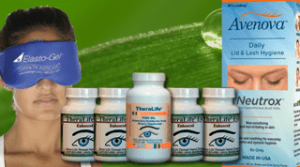 People who have dry eye disease (DED) or dry eye syndrome also suffer from depression, anxiety, or stress. There are many theories as to the cause: The chronic pain associated with the symptoms of DED, certain medications that treat depression that cause dry eyes, or an underlying physical problem that causes depression that can also cause DED. Fortunately, there are some ways to deal with DED and depression that bring people relief.
People who have dry eye disease (DED) or dry eye syndrome also suffer from depression, anxiety, or stress. There are many theories as to the cause: The chronic pain associated with the symptoms of DED, certain medications that treat depression that cause dry eyes, or an underlying physical problem that causes depression that can also cause DED. Fortunately, there are some ways to deal with DED and depression that bring people relief.
Dry Eye Syndrome
Resulting in damage to the surface of the eye, dry eye disease affects the tear production and ocular surface. Vision problems, interference with reading, working, or driving, and complications such as conjunctivitis, ulcers, or scars can be caused from DED. Itching, burning, redness, a feeling of something in the eye, and pain are a few of the symptoms of suffering from dry eyes.
Dry eye disease can affect anyone of any age. However, it seems more prevalent in females and older individuals. There are many factors that can cause dry eyes: smoking, surgery, hormonal changes, poor indoor air quality, dry air, and contact lenses are just a few. Experts have found that from one-third Up to half of a community can suffer from DED.
Depression and Dry Eye Syndrome
The symptoms associated with DED can have a negative effect on the quality of an individual’s life, mood, and mental health. When symptoms are severe, the individual’s perception of pain along with depression, stress, and anxiety can be present. It is also thought that those who do not suffer from DED initially may develop dry eye symptoms due to antidepressant medications.
The connection between depression symptoms and the symptoms of dry eyes is fairly stunning. Patients that did not take psychiatric medications, but still suffered from depression, were found to have dry eye syndrome almost three times more than their counterparts. If patients who take medication for depression are added into the mix, the numbers rise even higher. Therefore, doctors are now becoming aware of the fact that many patients who have never been diagnosed with depression should be evaluated when diagnosed with DED.
How TheraLife Helps Dry Eye Syndrome
The entire line of TheraLife Eye products work by restoring normal health to cells that are injured or performing poorly due to inflammation. These proven formulas increase microcirculation and blood flow which, in turn, deliver vital nutrients and medication to injured sites and reduces inflammation. When eyes are covered with protective tears, pain is eliminated and patients report relief.
If you currently suffer from chronic dry eyes, the TheraLife All-In-One Eye Enhanced Starter Kit is the perfect solution to help you find relief from dry eye symptoms and pain. By reducing irritation and inflammation of the tear glands, eyelids, and the surface of the eyes,
TheraLife Eye offers a powerful solution to dry eye syndrome without the use of eye drops. Included in the TheraLife All-In-One Starter Kit:
- TheraLife Eye Enhanced
- TheraLife Omega-3 Fish Oil
- Eye Lid Cleanser
- Elasto-Gel Hot Compress
Restoring your eyes’ natural ability to produce tears, this FDA-approved tablet has been clinically proven to work for 80% of first-time users. Complete with a 90-day money back guarantee, TheraLife Eye Enhanced heals the cells of the eyes by increasing the intracellular metabolism, membrane permeability, and blood circulation. When the tear glands are stimulated, they will secrete tears naturally.
TheraLife Omega-3 Fish Oil – Molecularly Distilled. 100% Contaminant-free
When tears are thin, they don’t cover the ocular surface. By using the purest fish oils that have been molecularly distilled, TheraLife Omega-3 Fish Oil thickens natural tears and prevents excess tear evaporation. As we age, our body produces less natural acids that our eyes need to function properly. TheraLife Omega-3 Fish Oil replaces these protective acids and aids in overall healthier eyes.
Clean eyes are healthy eyes. Therefore, TheraLife includes a gentle, refreshing, and soothing cleaner for the eyelids and eyelashes. Daily use helps prevent serious eye conditions, such as Blepharitis and Chronic Dry Eye Syndrome, from developing. Made with HyChlor- an all natural products which prevent re-attachments of bacteria and mites to stop blepharitis forever. Our eyelid cleanser contains no detergents which can cause soreness of eyelids.
A natural solution that provides relief for those suffering with chronic dry eyes, a hot compress is included in the TheraLife All-In-One Starter Kit for immediate soothing for dry, irritated eyes. Made of Elastogel, our hot compress retains heat and is easy to clean.
Get your life back on track today. Call us toll-free 1-877-917-1989 US/Canada) and talk to a doctor. Email to [email protected]
References
5.Vehof J, Kozareva D, Hysi PG, et al. Relationship between dry eye symptoms and pain sensitivity. JAMA Ophthalmol. 2013;131(10):1304-1308. doi:10.1001/jamaophthalmol.2013.4399
16. Schiffman RM, Christianson MD, Jacobsen G, Hirsch JD, Reis BL. Reliability and validity of the Ocular Surface Disease Index. Arch Ophthalmol. 2000;118(5):615-621. doi:10.1001/archopht.118.5.615
35. Okereke OI, Vyas CM, Mischoulon D, et al. Effect of long-term supplementation with marine omega-3 fatty acids vs placebo on risk of depression or clinically relevant depressive symptoms and on change in mood scores: a randomized clinical trial. JAMA. 2021;326(23):2385-2394. doi:10.1001/jama.2021.21187
42. Schaumberg DA, Dana R, Buring JE, Sullivan DA. Prevalence of dry eye disease among US men: estimates from the Physicians’ Health Studies. Arch Ophthalmol. 2009;127(6):763-768. doi:10.1001/archophthalmol.2009.103






I didn’t realize that it is more common for women to have dry eye disease. Whenever my wife wakes up in the morning, she has a very difficult time seeing without putting eye drops in her eyes, she says that they tend to get very dry and cause her vision to get blurry. Now that I know that women are more likely to have dry eye disease, I’ll look for an optometrist who can help us find a solution to her problem.
Stefan- Theralife can help. check out our web site. https://www.theralife.com/dry-eye-treatment/
Dr. Lily C. Yang-Theralife Inc.